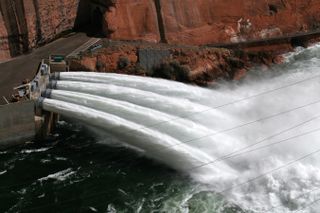
Restorative Flood in Grand Canyon Starts Sunday Night

The Colorado River will gush at flood stage starting Sunday night (Nov. 18), giving rafters a rare thrill and hopefully restoring beaches and native fish habitat in the Grand Canyon.
The six-day-long water release from Glen Canyon Dam is the first of many floods planned by the Department of the Interior through 2020. The floods, or "high-flows," are an effort to restore the river's natural environment for both tourists and wildlife.
"The high-flow does mimic a natural event, and that is a good thing for the ecosystem," said Glen Knowles, chief of the adaptive management group at the Bureau of Reclamation's Salt Lake City office.
Since the dam was completed in 1966, the Colorado River, once copper-colored with sediment, now runs clear. While sand and mud piles up behind the concrete barrier, natural beaches and sandbars have disappeared, allowing predatory non-native fish such as rainbow trout to flourish. Bushes and trees, once buried or ripped away during periodic floods, now choke popular camping sites for river rafters. [Top 10 Most Visited National Parks]
Deluge to build new beaches, habitat
The goal of the flood is to park sediment high along the walls of the Grand Canyon.
"The beaches have changed rather dramatically since the dam was put into place, and we can rebuild those beaches to an extent," said Knowles, who was involved in planning and developing the high-flow release protocol. "The same sandbars that create the beaches also create backwater habitat for native fish," he told OurAmazingPlanet.
Sign up for the Live Science daily newsletter now
Get the world’s most fascinating discoveries delivered straight to your inbox.
The high-flow release plan was announced in May by Secretary of the Interior Ken Salazar. Developed after more than 16 years of planning and testing, the strategy allows flood releases on short notice, without extensive environmental review or planning, through 2020. The order calls for flows from 31,500 to 45,000 cubic feet (892 to 1,274 cubic meters) per second for up to 96 hours in March-April and October-November,.
Flood tests were conducted in 1996, 2004 and 2008. These three blasts helped rebuild beaches and protect native fish such as the federally threatened humpback chub, but the newly deposited sediment quickly eroded. Researchers also found that without sufficient sediment below the dam — dumped by the Paria and Little Colorado rivers — the reservoir water was too cold for the humpback chub to spawn.
Careful monitoring required
The new plan authorizes dam releases when enough sediment has been deposited by the free-flowing Paria and Little Colorado, Knowles said. Tests by the U.S. Geological Survey found the Paria River dropped 538,000 metric tons of sand into the Colorado River between late July and the end of October, so there's enough sediment to merit a flood now. [Related: The Grand Canyon in Pictures]
However, spring floods won't start until 2015. Plans for spring floods changed because 2008 and 2011 produced huge spawns of rainbow trout, Knowles said. The deluge cleans mud and sand out of gravel near the dam where the rainbow trout like to lay their eggs, creating good spawning conditions. "We felt as a conservation measure, we would forgo any spring flows until 2015 to not make the situation worse," he said.
There are now approximately 2 million rainbow trout and 10,000 humpback chub in the Colorado River ecosystem. "That is not an acceptable ecosystem," said Nikolai Lash, a program director at the conservation group Grand Canyon Trust.
The trust has pushed for annual floods in the Grand Canyon for more than 15 years, including in a lawsuit filed in 2008. "I really welcome this change in policy and implementing high-flow program," Lash said, "The beaches are in a very diminished condition, and the high-flow experiments, whether they are done in the spring or the fall, are likely to do good things for the canyon."
The USGS will monitor the effects of the high-flow release throughout the canyon and report back to the Bureau of Reclamation and affected stakeholders, including the trust and Native American tribes, Knowles said.

High flows will cost power companies
Glen Canyon Dam powers more than 1.5 million homes, mostly in rural and suburban Utah. Residents there will absorb the costs of water bypassing Glen Canyon’s turbines, which in the past have come to $3 million to $4 million. When water bypasses the turbines, the association must meet contracted demand by purchasing power generated elsewhere, said Leslie James, executive director for the Colorado River Energy Distributors Association.
Next week's release will cost the group about $1.4 million,James told OurAmazingPlanet. Later this year, the association will also need to accommodate lower-than-average flows, because only a finite amount of water is released from the Lake Powell reservoir each year.
Currently the Bureau of Reclamation plans to ease the blow by dropping flows in February and April, typically low-demand months, James said. The amount of water flowing through Glen Canyon Dam's turbines affects the power-generating capacity. "We appreciate the efforts of Reclamation and Western to look at scenarios that will have less impact," James told OurAmazingPlanet.
The total maximum release from the dam next week will reach approximately 42,300 cubic feet (1,197 cubic meters) per second for 24 hours. The flood will last six days, from Nov. 18 at 11 p.m. to Nov. 23 at 8 p.m. The water level at Lake Powell will drop 2 to 3 feet during the release.
The National Park Service has alerted Grand Canyon National Park river rafters that boats may travel at double the normal speed and that some camp areas may be inundated. Water along the Lake Mead corridor from Pearce Ferry to South Cove also will increase and speed up, and could carry away camping equipment or boats left unsecured on the shore.
Reach Becky Oskin at boskin@techmedianetwork.com. Follow her on Twitter@beckyoskin. Follow OurAmazingPlanet on Twitter @OAPlanet. We're also on Facebook and Google+.

